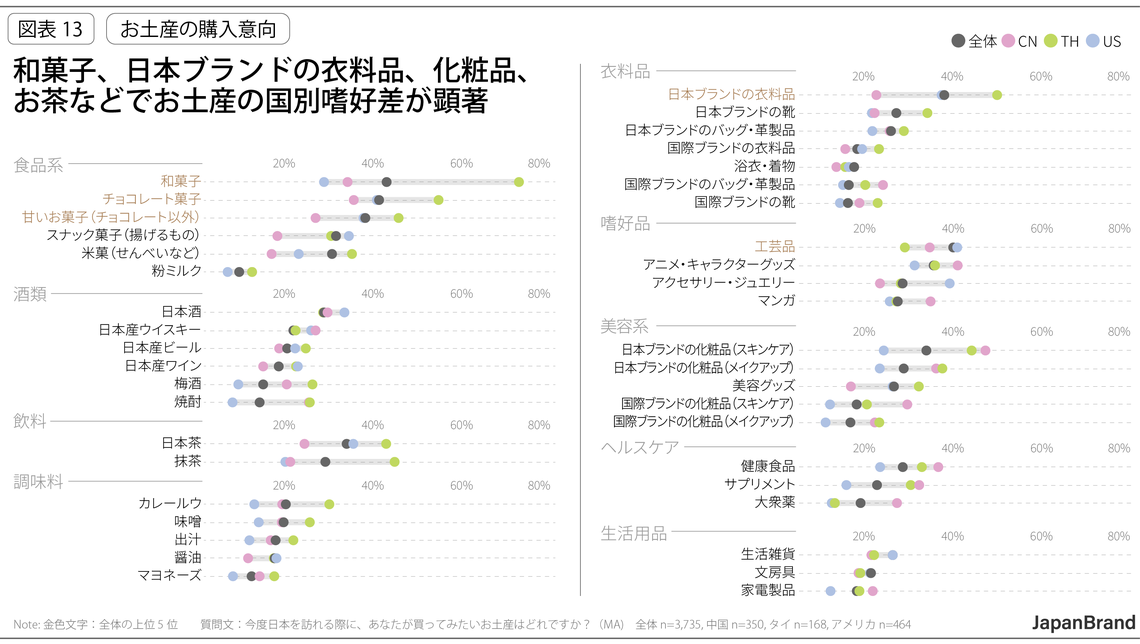Note: This website was automatically translated, so some terms or nuances may not be completely accurate.
The Expanding and Deepening World of the Japan Brand
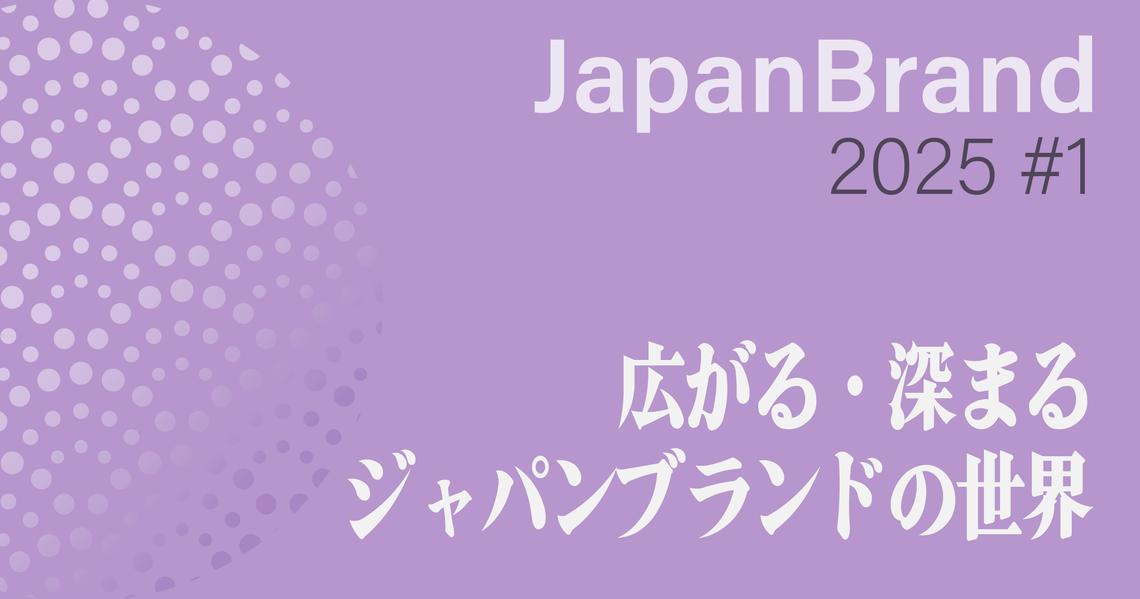
Launched in 2011, the Japan Brand Survey is Dentsu Inc.'s proprietary knowledge foundation initiative that regularly gauges the awareness and actual practices of overseas residents regarding the Japan brand as a whole. This encompasses areas such as inbound tourism, regional revitalization, the food sector, Japanese products, content, values, lifestyles, and social trends.
Marking its 15th anniversary in 2025, the survey conducted its largest-ever quantitative research. Covering 20 countries/regions ( survey overview ), over 20 industry sectors, and more than 10 themes, it enables the acquisition of more multifaceted and actionable insights than ever before.
In today's era where unpredictability and uncertainty have become the norm, we hope this survey will continue to provide hints for moving forward into the future and offer a relativistic perspective to avoid cognitive biases, thereby contributing, however modestly, to building a sustainable society.
<Table of Contents>
▼Japan's Competitiveness in International Tourism
▼Visitor Experiences and Consumption Trends
▼Key Issues for Tourism in Regional Revitalization
▼Toward a Sustainable Future
Japan's Competitiveness in International Tourism
Japan was cited by the highest percentage of global travelers with overseas experience as the country they most want to revisit for tourism, exceeding half of respondents. This represents a significant gap over second-place South Korea and third-place United States, clearly demonstrating Japan's outstanding popularity compared to other countries. (Figure 01)
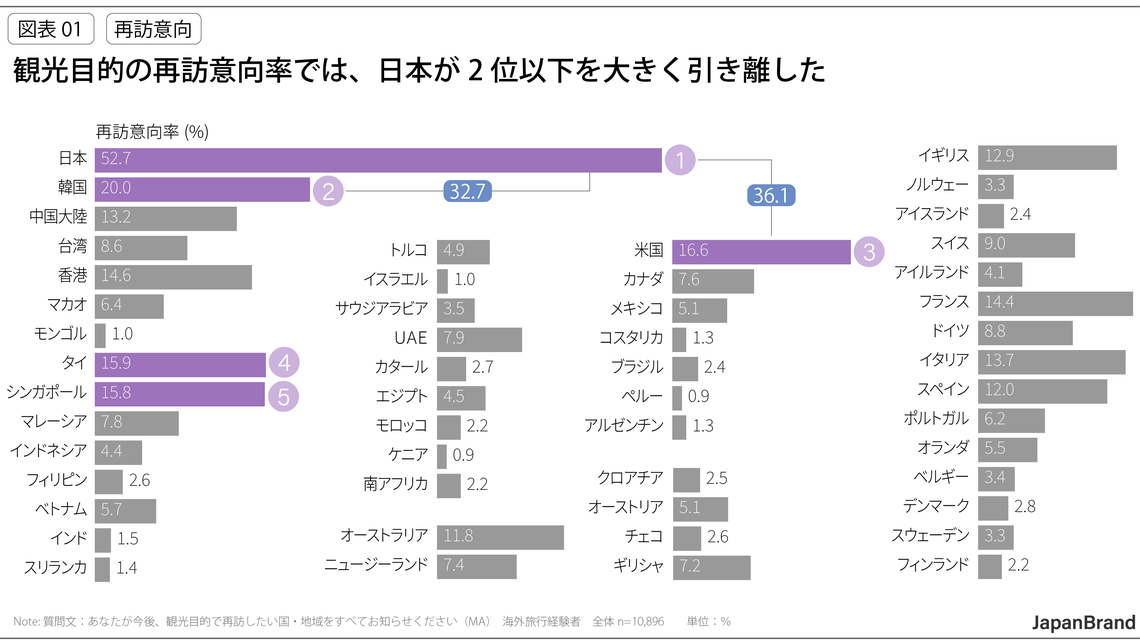
Furthermore, when broken down by country/region, Japan ranked first as the desired destination for return visits in 13 out of 20 surveyed countries/regions. While the margin varied by market, Japan consistently outpaced the second-place contenders by a wide margin. This demonstrates that Japan has firmly established itself as a leading travel destination across a broad swath of the Asia-Pacific region. (Figure 02)
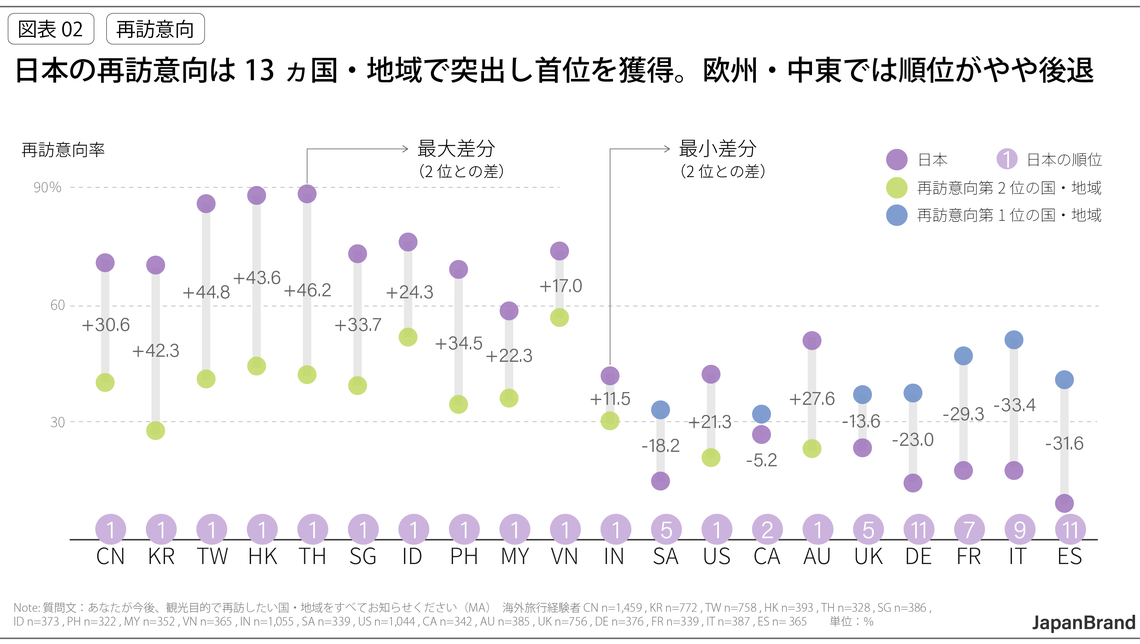
Amidst the continued growth in foreign tourists, the intention to revisit for tourism purposes is also steadily increasing year by year. While it is undeniable that the historically weak yen has lowered the barrier to visiting Japan and broadened its appeal, the results of this study reveal that, except for Hong Kong and Taiwan, the weak yen is not the primary motivation for visiting Japan.
For many travelers, the reasons for visiting Japan are rooted in fundamental factors like experiential value and cultural appeal, rather than just favorable exchange rates. This trend suggests that tourism to Japan is not a fleeting fad, but is being sustainably embraced as a destination with significant appeal.
While the accumulation of positive experiences in Japan naturally increases the intention to revisit, the challenge going forward, amidst growing domestic labor shortages, lies in "how to maintain satisfaction with Japan tourism." (Figure 03)
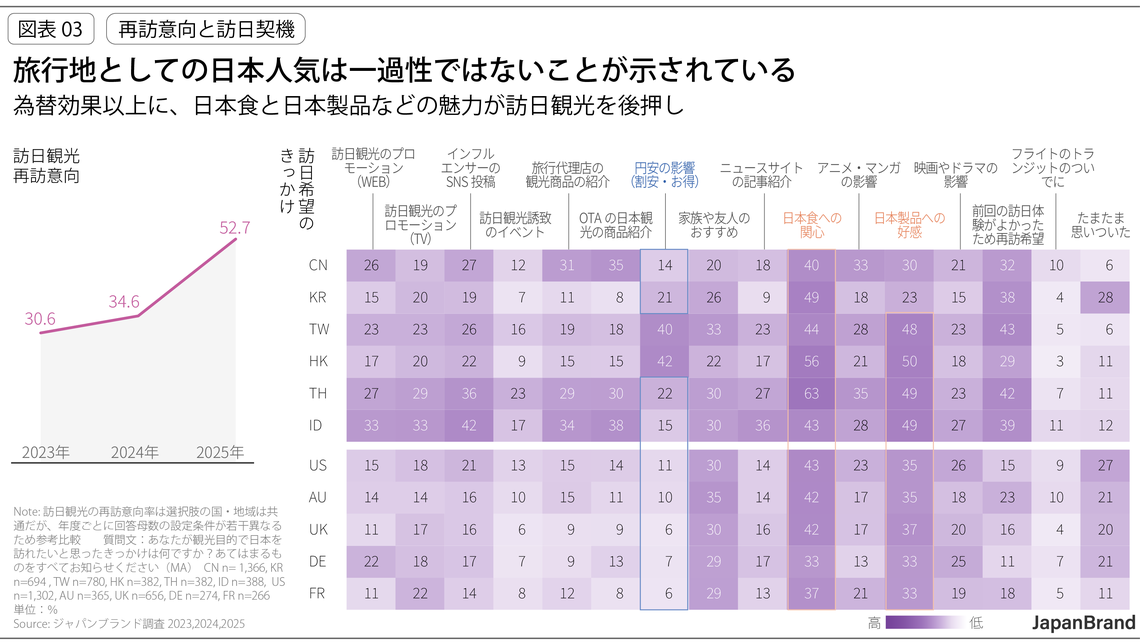
Furthermore, when comparing Japan with other overseas travel destinations, no significant differences were found in the fundamental elements travelers seek. While many cite "natural scenery," "food culture," and "traditional culture" as primary travel purposes, environmental aspects like "safety and security," "healing and relaxation," "exotic atmosphere," and "cleanliness" are also highly valued.
This indicates a growing interest in experiential consumption overall. It also suggests that tourism experiences are not merely about consuming resources, but represent actions seeking multifaceted value—such as physical and mental recovery and enjoying the extraordinary—and that we must not lose sight of the essence of travel. (Figure 04)
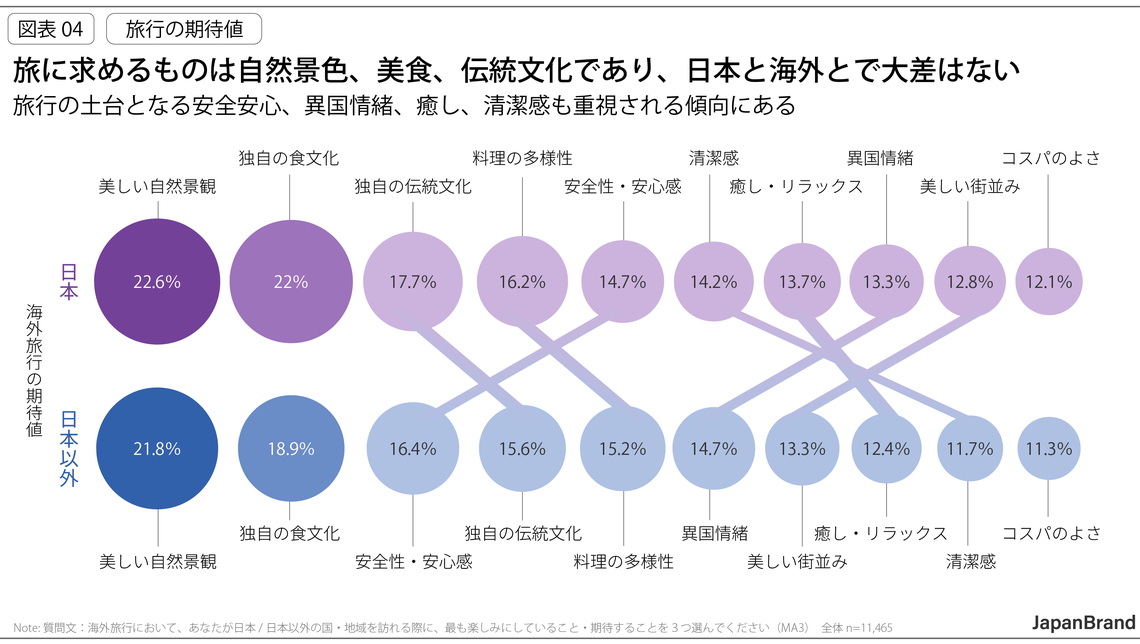
When viewed by country/region, slight differences emerge in expected value trends. Australian travelers are strongly drawn to "unique food culture" and "healing/relaxation," while in the UK, expectations for "unique traditional culture" and "cleanliness" were highly valued. Conversely, in the US, no significant bias toward specific items appears evident. (Chart 05)
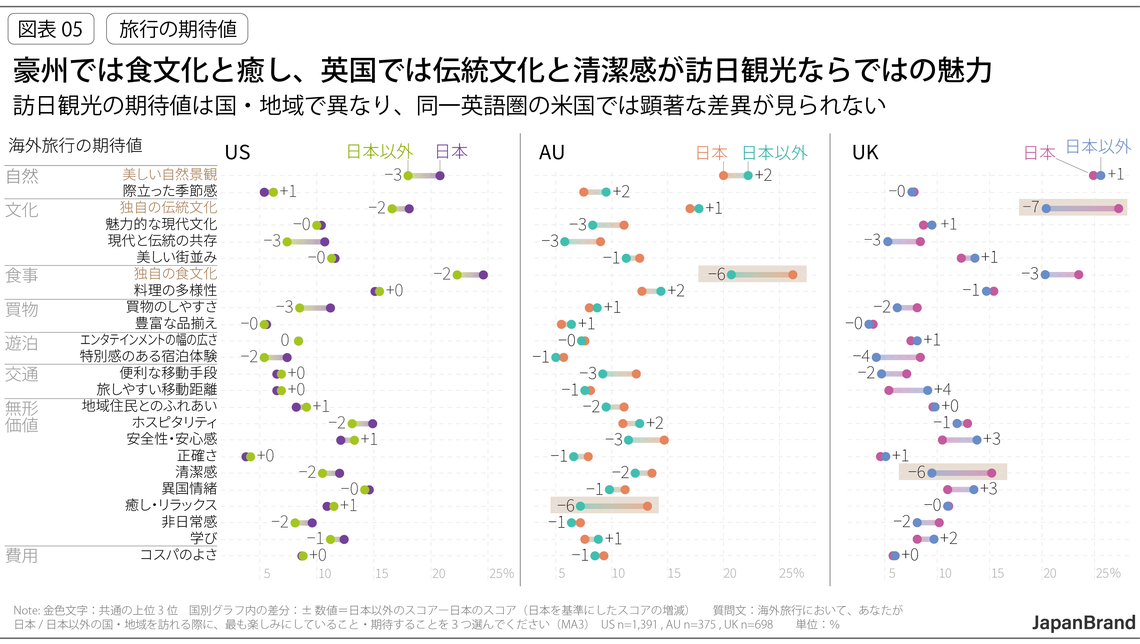
The inbound market, having grown to an 8 trillion yen scale, now rivals the domestic apparel industry and possesses external demand-driving power equivalent to roughly half of automobile export revenue (*1). The significance of inbound tourism cannot be fully captured within the framework of tourism alone. Globally, nearly all top countries in visitor numbers and foreign exchange earnings possess robust soft power as a foundation, attracting consumers with an intrinsic appeal that transcends physical constraints like borders and language.
While concerns and anxieties about tourism dependency are occasionally voiced, inbound consumption's contribution to Japan's GDP remains around 1% as of 2024, still relatively low compared to G7 nations and OECD member countries. While addressing overtourism is necessary, we must separate this from discussions fearing excessive tourism dependence. We need to calmly organize the issues and promote understanding, based on realistic industrial ripple effects and the potential for economic contribution.
The revisit intent we focus on functions not only as a quantitative evaluation metric for inbound tourism but is positioned as a highly sensitive indicator that simply and clearly visualizes the fundamental human desire to "visit again." Furthermore, this study reaffirmed that the strength of "sustainable competitiveness in international tourism"—which evokes the desire to revisit—is underpinned not only by tourism resources but also by broader cultural and social factors, such as interest in Japanese food culture and trust in Japanese products.
※1 Source: Ministry of Finance "Trade Statistics" (2024)
Visitor Experiences and Consumption Trends
Highly sought-after experiences during visits to Japan include "Japanese cuisine" and "natural scenic spots," which are emblematic of Japanese culture, as well as "experiencing the four seasons," "strolling through bustling downtown areas," and "experiencing traditional culture." Among these, "shopping at convenience stores" garners significant interest despite its seemingly mundane nature, with particularly strong support observed in Asian regions.
These results suggest that the appeal of visiting Japan extends beyond the extraordinary; the refined everyday culture and infrastructure itself hold strong appeal. Naturally, preferences for experiences vary by cultural region. As the inbound market expands and repeat visitors from neighboring regions increase, future business expansion, product/service development, and marketing strategy planning must consider tailored approaches for each target region. (Figure 06)
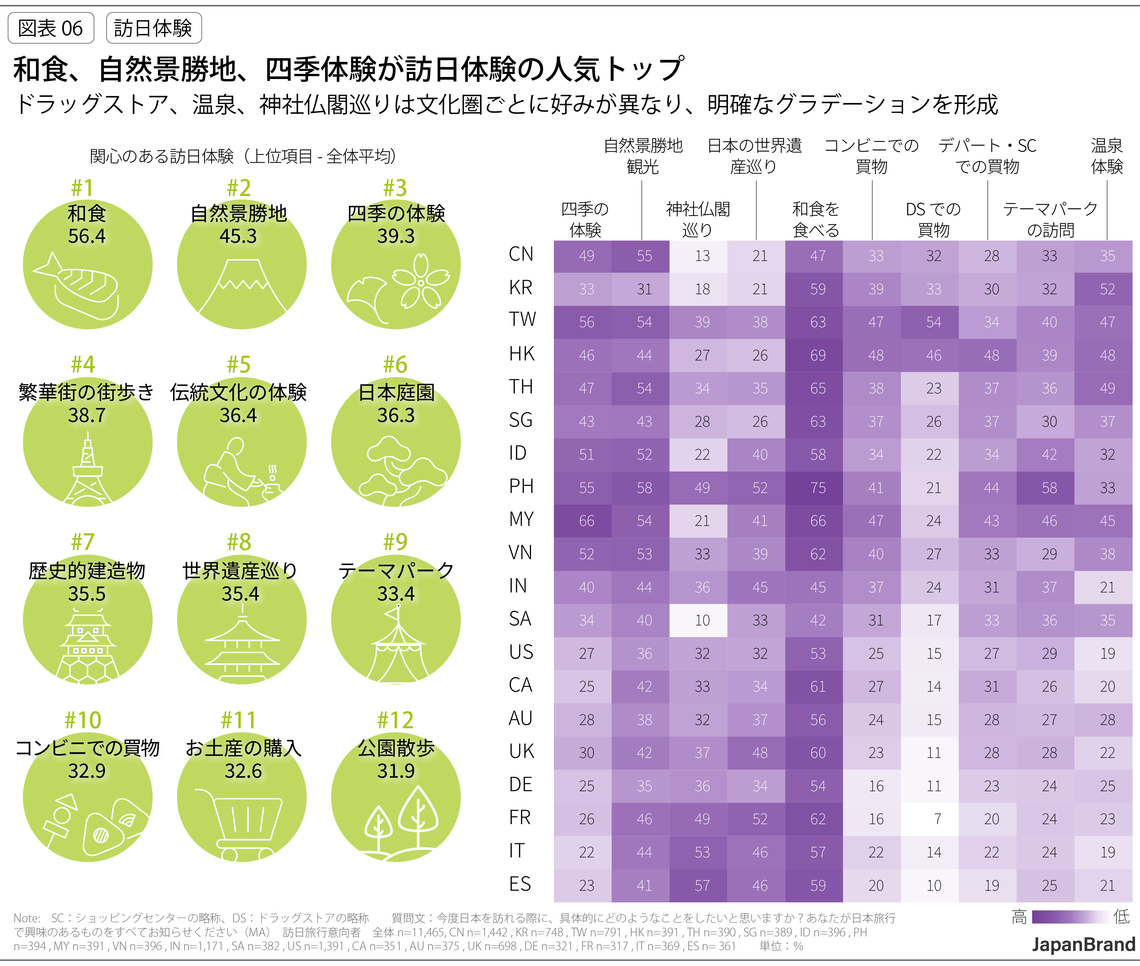
Let's further break down the Japan experience.
Among nature experiences, "cherry blossom viewing" stands out as overwhelmingly popular, firmly establishing itself as a quintessential Japanese tourism experience. Other experiences like "hot spring bathing," "nature walks," and "autumn foliage viewing" also demonstrate broad recognition of Japan's diverse natural resources and their appeal. (Chart 07)

Regarding cultural experiences, there is a strong tendency toward interest in uniquely Japanese events and spiritual culture, such as "seasonal traditional events," "tea ceremony," and "festival viewing." Areas that are relatively easy for overseas residents to understand as symbolic Japan and where they can easily feel extraordinary value ranked highly. (Chart 08)
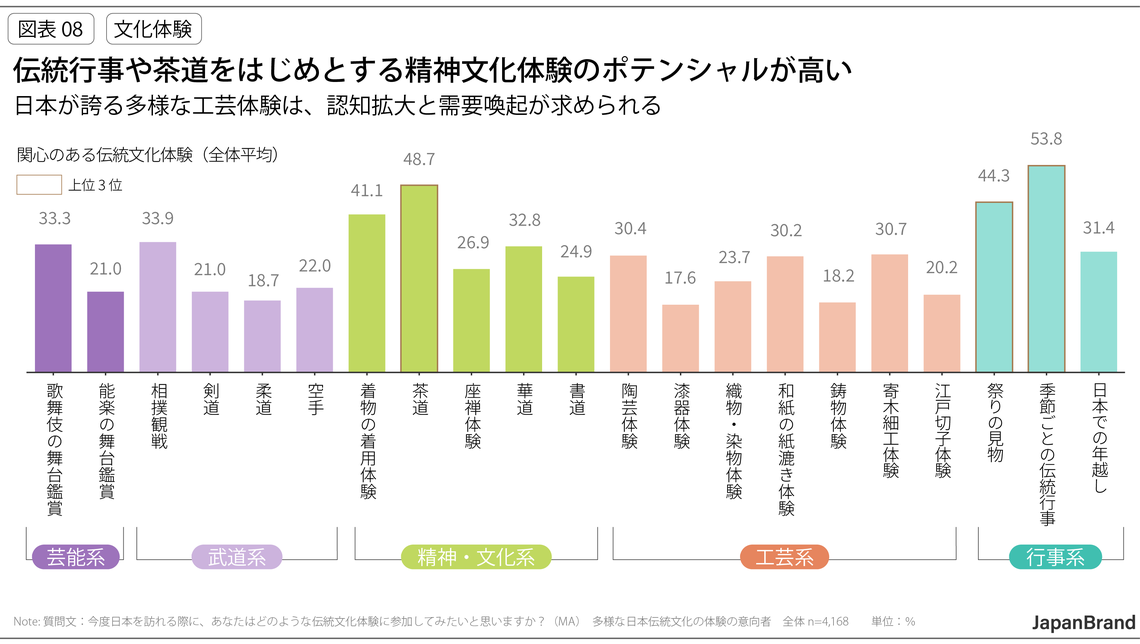
Furthermore, when asked about symbols of "Japan-ness," "sushi," "cherry blossoms," and "Mount Fuji" were cited as representative examples. These images are thought to influence the entire travel experience, including motivations for visiting Japan, destination selection, and preferred travel times. However, these symbols are not uniform. For example, in Vietnam, elements like "tea ceremony," "udon," and "automobiles" are cited as representing Japan, while in France, "judo," "bonsai," and "soy sauce" are highlighted. The differing cultural receptions across markets offer important insights not only for inbound tourism but also for the overseas export of Japanese products and services. (Chart 09)
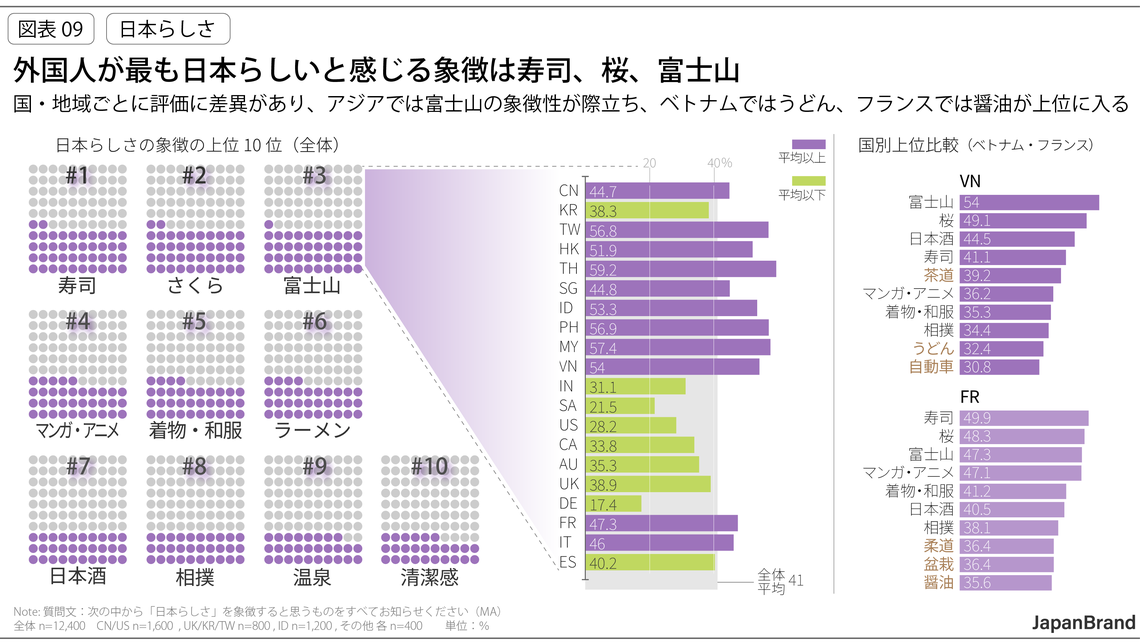
Generational differences also merit attention. Among Generation Z, interest in "manga and anime" sometimes surpassed that in "Mount Fuji" or "sushi." Furthermore, as the number of visits to Japan increases, sensitivity to Japanese culture, such as "autumn leaves," "hot springs," and "festivals," tends to grow, while interest in "cherry blossoms" shows a relative decline. This suggests a linkage between deepening experiences and evolving interests. (Figure 10)
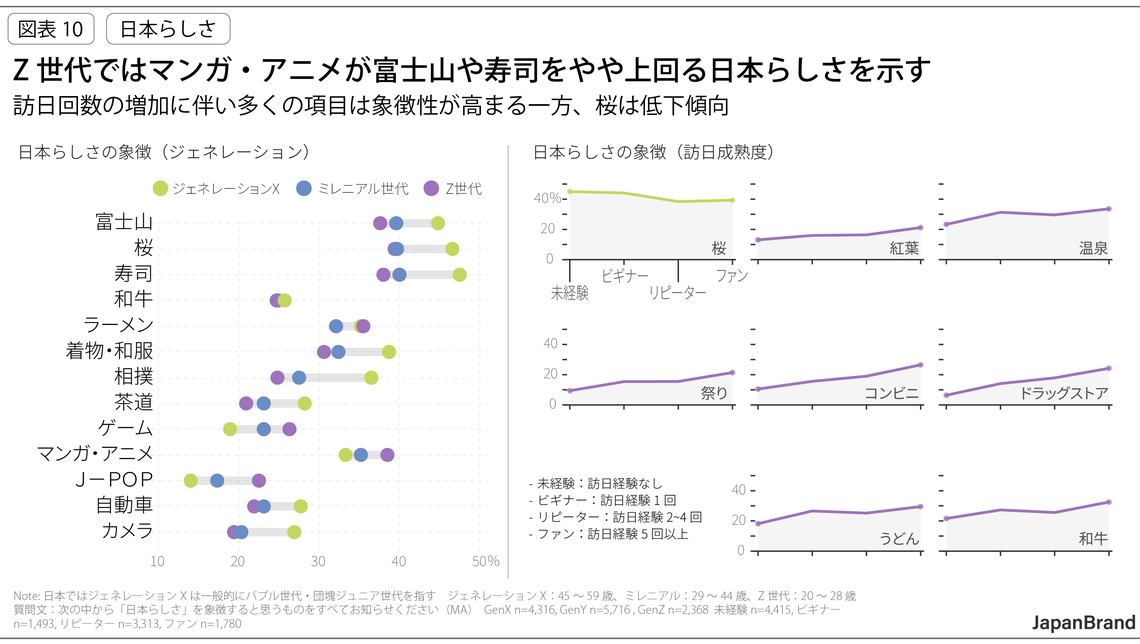
Regarding purchasing intentions at commercial facilities, convenience stores showed relatively high selection rates, highlighting familiar Japanese snack cultures like "sushi," "ice cream," and "rice balls/sweets." At drugstores, interest focused on product categories such as "skincare," "makeup," and "body care/supplements." Furthermore, indicators like selection rates and quantity chosen reveal significant consumption intent in the Asian market, suggesting active consumer behavior and potential. (Figures 11, 12)
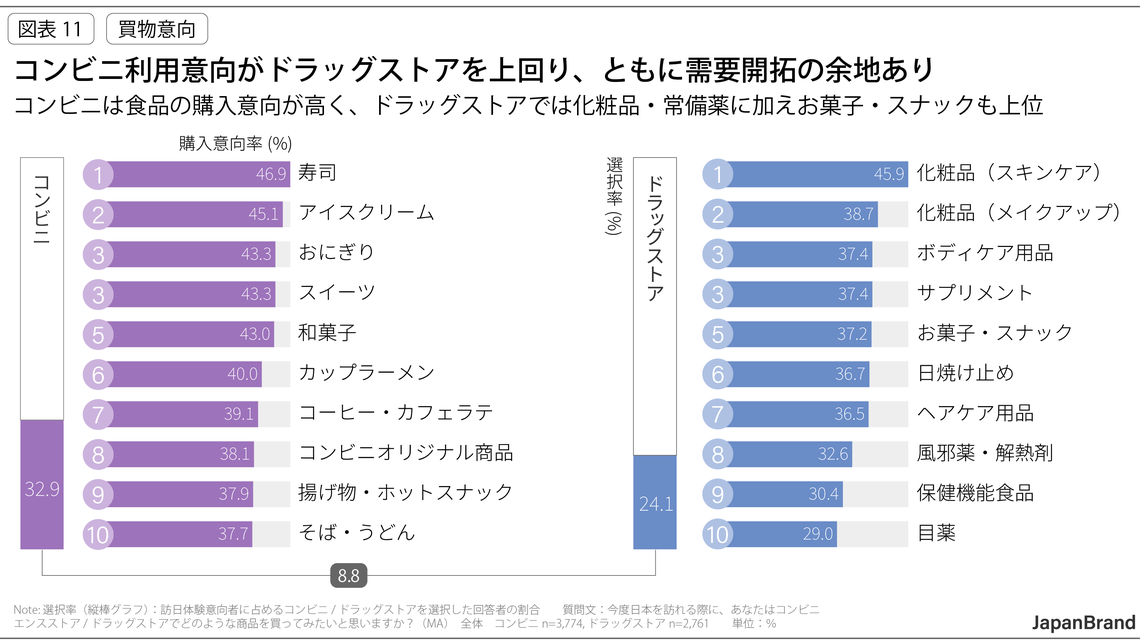
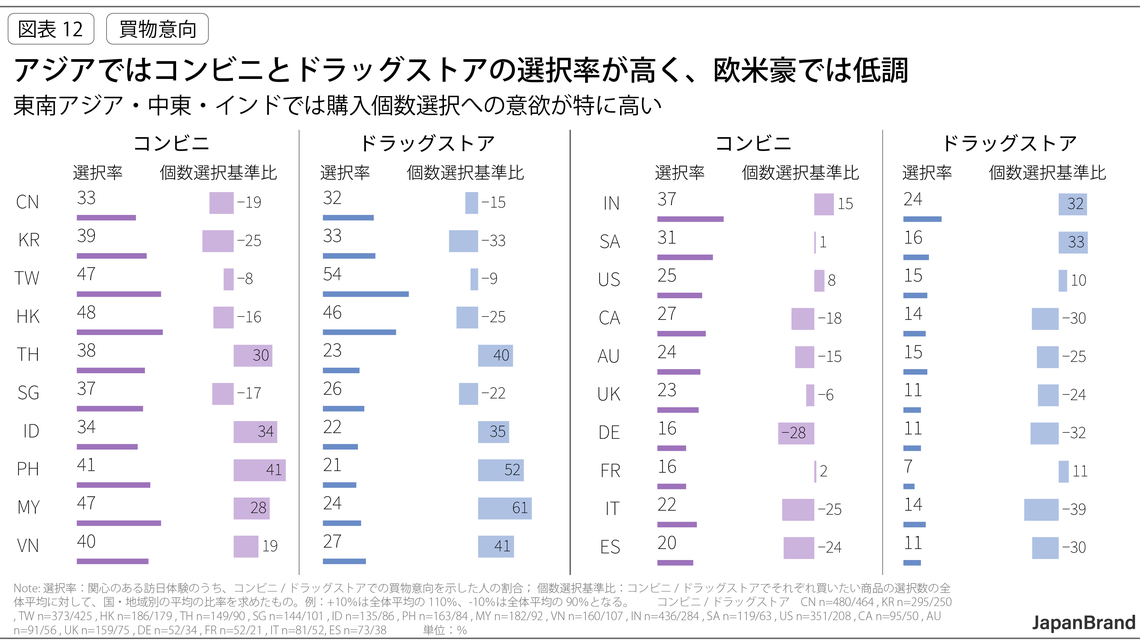
Regarding souvenir purchase intentions, items blending tradition and modernity, such as "Japanese sweets" and "crafts," are popular. Preferences also clearly differ by country/region for items like "Japanese brand apparel," "tea (Japanese tea, matcha)," and "cosmetics." This underscores the fundamental need for country-specific marketing strategies when appealing to these products. (Figure 13)
Tourism Issues in Regional Revitalization
Meanwhile, the Matthew Effect (※2) is at work, creating a structural challenge of "concentration due to strength." The multifaceted nature of this issue became clear across several dimensions: disparities in awareness of regional areas, uneven distribution of visit timing, biased understanding of what constitutes "Japanese-ness," and regional differences in awareness and visit intent for commercial facilities.
※2 Cumulative advantage. A phenomenon where favorable evaluations of outstanding individuals or organizations tend to lead to further success.
When comprehensively examining prefectural-level awareness, visit experience, and future visit intentions among inbound travelers, "Tokyo Metropolis" overwhelmingly leads, followed by widely known tourist destinations like Hokkaido, Osaka Prefecture, and Kyoto Prefecture. Notably, little fluctuation has occurred in this top tier over the past decade, suggesting that prefectural brand power has become somewhat fixed. (Figure 14)
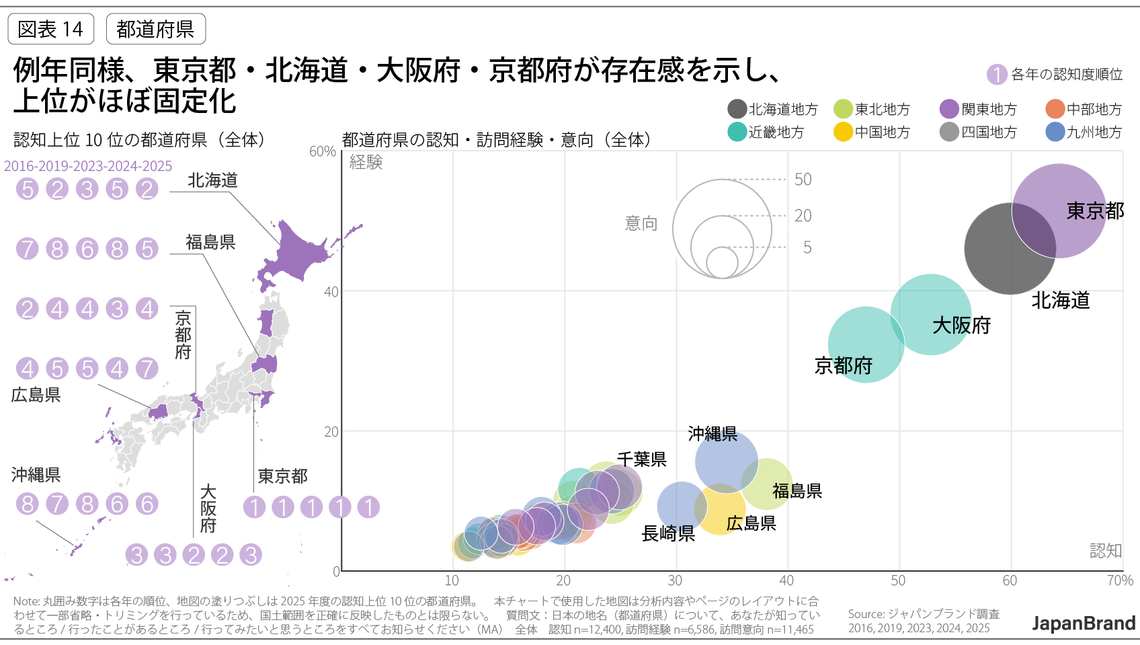
A more detailed analysis at the city level reveals that Sapporo, Osaka, and Kyoto stand out with exceptionally high recognition, clearly distinguishing themselves from other government-designated cities and core cities. While other cities also enjoy some recognition, there is a clear gap in visitation experience compared to the top cities, and little variation is seen within the same group. This highlights the dilemma between awareness and action: mere recognition does not directly translate to visits, yet without recognition, a destination won't even be considered as a visit option. (Figure 15)

The proportion of travelers visiting regional areas outside the so-called "Golden Route" (Tokyo, Nagoya, Osaka, Kyoto) remains low. Furthermore, this proportion shows significant variation between countries and regions.
Conversely, satisfaction among travelers who visited regional areas is exceptionally high, with over 90% expressing a desire to revisit, highlighting the outstanding value of the experience. This serves as a prime example demonstrating that regional tourism still holds significant potential. (Figure 16)
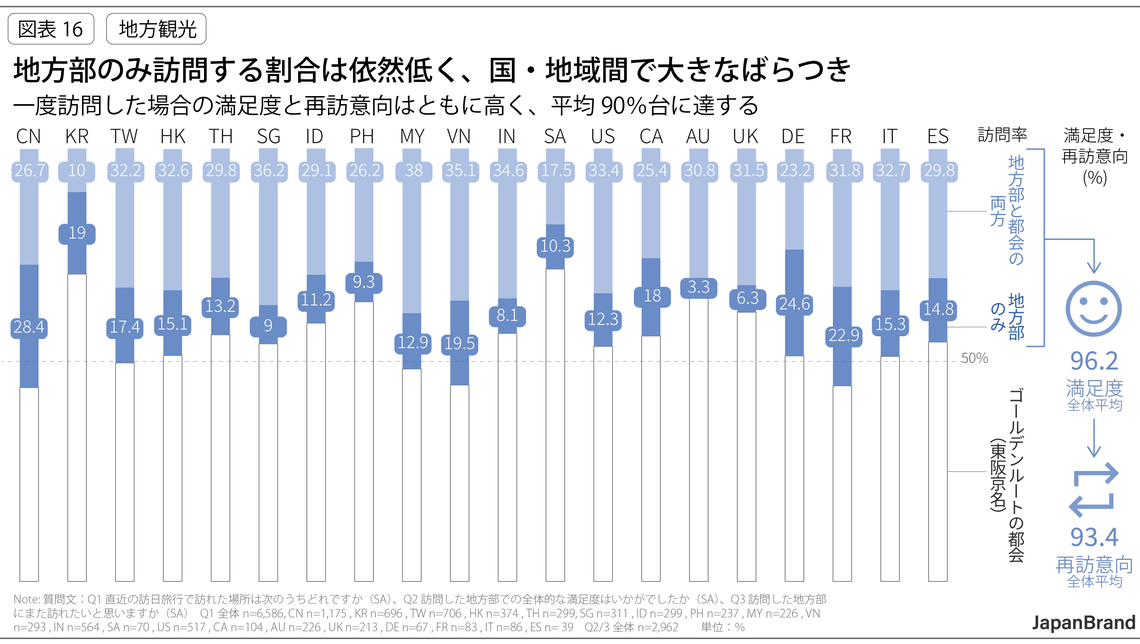
Regarding hot spring resorts, a symbolic resource of regional tourism, there are significant differences in recognition levels by country and region.
Particularly in English-speaking and Western cultural regions, a high proportion of respondents were unfamiliar with all presented hot spring destinations; approximately 75% of Canadians fell into this category. Similar results were seen in Australia and Spain, where around half were unaware, suggesting challenges in information dissemination. (Figure 17)

Travelers who actually visited regional areas cited various challenges, including communication infrastructure, Wi-Fi availability, lack of multilingual support, and accessibility. Furthermore, the specific challenges perceived differ significantly by country and region. (Figure 18)
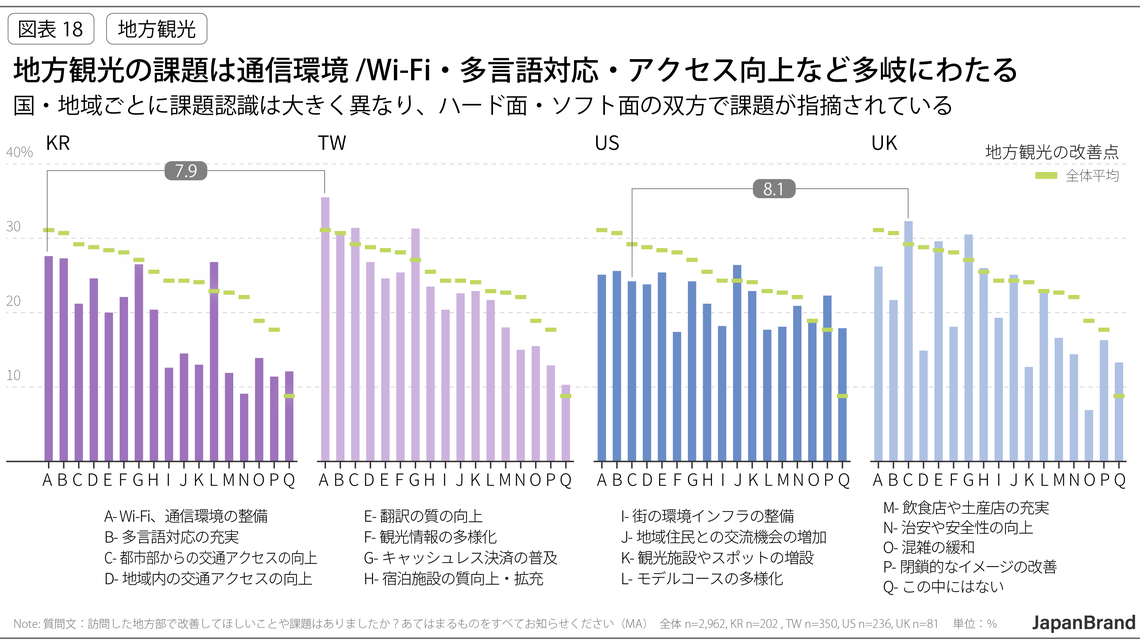
Given the limited total volume of visitors to regional areas (based on total foreign overnight stays) – approximately 30% of the total – and its skewed composition (with East Asia accounting for about 50%*3), strategic market selection is essential to expand business opportunities in regional tourism. After relatively comparing cultural receptivity and maturity in visiting Japan, it is essential to accurately identify markets that should be cultivated over the medium to long term and those that can contribute to the regional economy in the short term. This requires the courage and initiative to proactively formulate and execute a vision, including measures to expand on-site consumption.
※3 Source: Japan Tourism Agency "Accommodation Travel Statistics Survey" (2024)
Toward a Sustainable Future
This study believes that creating value for a sustainable future, aiming to balance economic and social value, can only be achieved through collective intelligence. This year, we visualized insights from overseas residents from multiple angles, focusing on three key elements: "Overtourism," "Reuse Value," and "Well-being."
None of these are simple themes with quick, straightforward conclusions. Despite constraints in report creation, as the research body, we present some insights focused on resident data. We hope these serve as hints for the thoughts and actions of people across various industries and positions who collectively support the foundation of social life.
Consideration 1: Overtourism
To avoid concentrated tourism demand and achieve sustainable inbound tourism, dispersing travel periods and destinations is essential. However, the current situation shows a significant skew toward the "cherry blossom season" as the preferred time to visit Japan. Many travelers cite "wanting to enjoy the scenery unique to that season" as their reason. While this speaks to the high symbolic appeal of Japan's four seasons, it simultaneously contributes to the challenge of overtourism. (Figure 19)

Meanwhile, interest in visiting Japan during periods following the cherry blossom season tends to be dispersed across different countries and regions. Particularly for frequent visitors, the so-called "Japan fans," the "autumn foliage season" could become the next core demand driver. Furthermore, in the U.S. market, the intention to visit Japan during the "summer vacation season" is relatively high, revealing a demand pattern distinct from that of the Chinese market. (Figure 20)
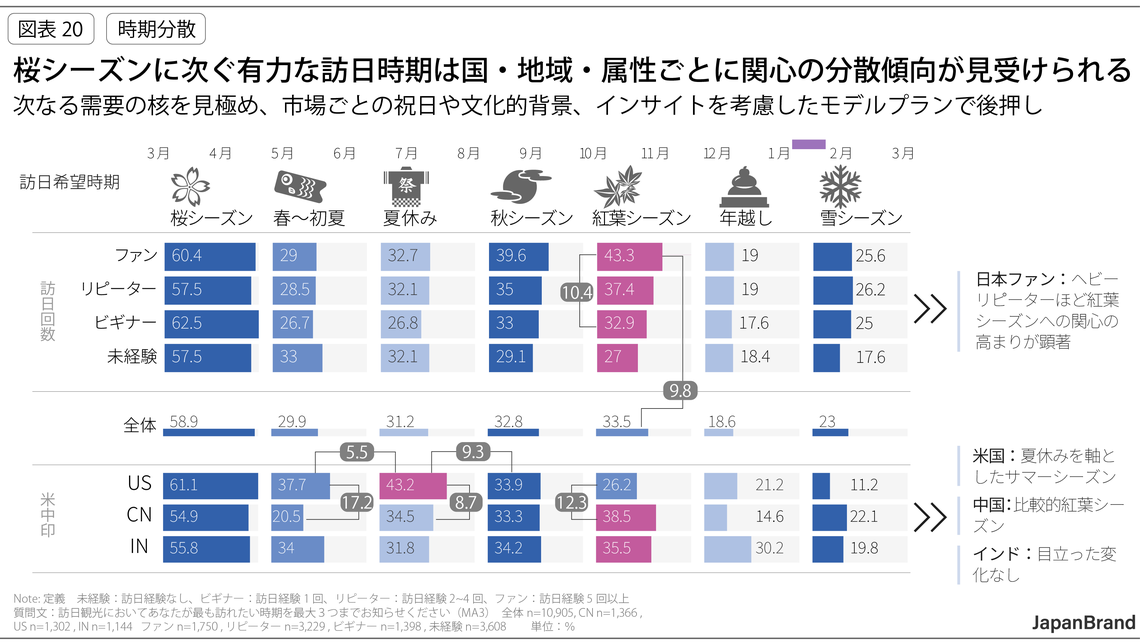
This concentration of demand in Japanese tourism (both geographical and seasonal) is not unique to Japan. It is generally recognized as a common challenge for advanced tourism nations worldwide, one that remains in the process of being resolved. (Figure 21)

When considering demand leveling, the author believes three perspectives are essential: insects, fish, and birds.
- Observation and organization through the "insect's eye": Refining the understanding of the current situation by deciphering the deep psychology of consumers, taking stock of existing assets, and extracting challenges.
- Mutual understanding through the "fish's eye": Collaborative creation of a future vision through repeated alignment with local residents and research into other countries and advanced examples.
- "Bird's-eye view" guidance and support: Administrative monitoring and strategic policy formulation to support early issue detection and constructive solutions.
Furthermore, recognizing the limitations of pursuing economic rationality alone, a cross-disciplinary approach incorporating sociology and psychology will be required in various contexts.
Consideration Factor 2: Reuse Value
From the perspective of the circular economy, the reuse of secondhand goods is a crucial element. This survey revealed that interest in secondhand goods in Japan is exceptionally high overall and is attracting attention regardless of country or region.
In particular, Japanese products are highly valued by consumers for their "good condition" and "high durability." These characteristics contribute to the competitive strength of Japanese goods, underpinned by Japan's unique reliability and values. Such evaluations can also serve as a foundation for creating and expanding circular industries and for differentiation strategies that are difficult to imitate. (Figure 22)
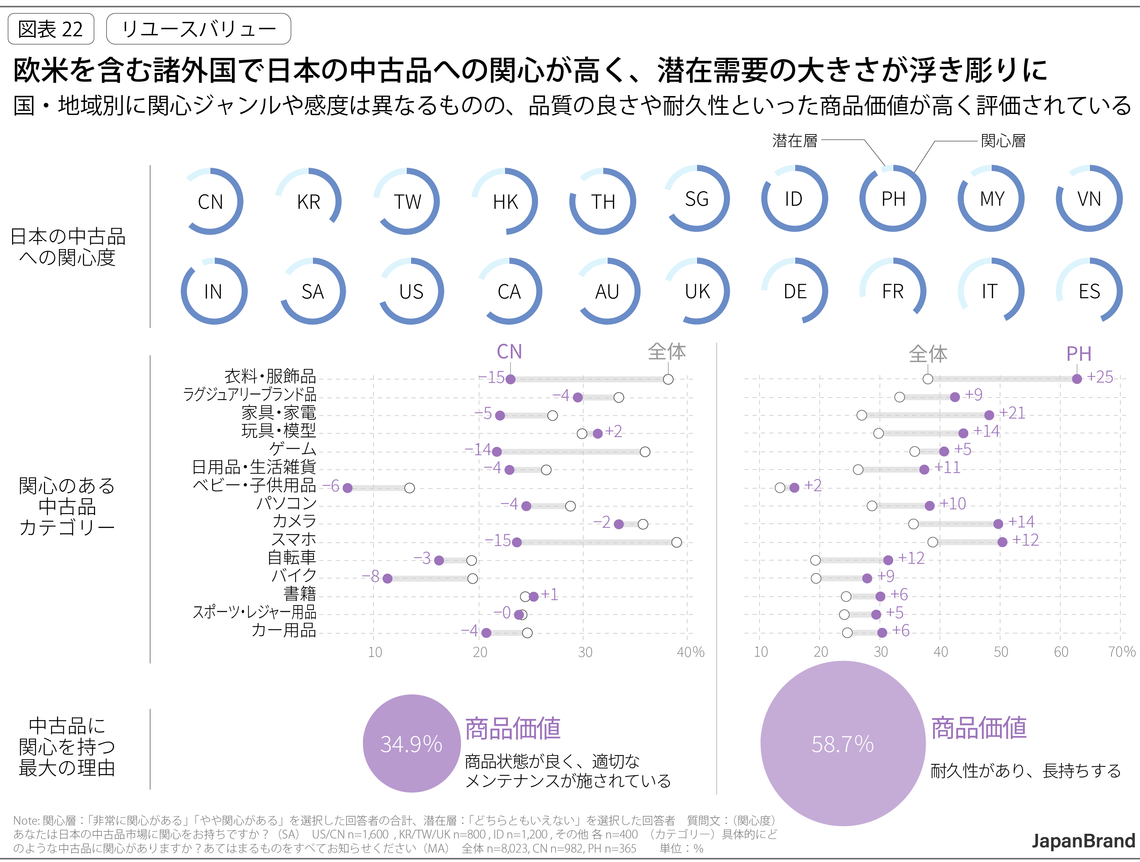
Japan's secondhand market strongly reflects the inherent product values of Japanese goods, such as high quality and durability. The ability to acquire reliable Japanese products at affordable prices compared to new items is a major advantage attracting global attention. Furthermore, cultural elements unique to Japan are driving interest in secondhand goods, particularly in Southeast Asian countries. This includes items with cultural heritage value like kimonos, antiques, and traditional crafts; distinctive fashion styles such as Harajuku and street fashion; the fashion appeal of vintage clothing; and even pop culture goods related to anime, manga, and games.
When considering the reuse value of secondhand goods, it goes without saying that product value forms the core of the market. However, to strategically expand the customer base over the medium to long term, it is essential to consider the following broader aspects alongside product value.
- Experiential Value: Providing user experiences infused with Japanese culture, creating new meanings through collaborations and upcycling.
- Social Value: Achieving value transformation through sustainability perspectives and gaining social resonance via education and awareness campaigns on the circular economy.
This involves both a defensive strategy of "environmentally conscious reuse" and an offensive strategy of "cultural and market expansion to elevate brand and business value." Combining these approaches will likely enable Japan's secondhand goods market to evolve beyond a mere "place for trading goods" into a "sustainable ecosystem connecting culture, society, and economy."
Consideration Factor 3: Well-being
In daily life, values emphasizing quality of life were notably prominent, such as "ensuring work-life balance," "maintaining desired living standards," and "comfortable, low-stress living environments."
These items tend to be highly valued, particularly among Generation Z, suggesting a shift in the values of younger generations. (Figure 23)

Additionally, among socially relevant themes, topics related to technology, health, and sustainability—such as "utilizing generative AI," "renewable energy," "health tech," and "mental health"—ranked highly. Notably, Gen Z women showed particularly strong interest in "mental health," highlighting differences in areas of focus across generations and genders. (Figure 24)

This survey consistently reveals how the turbulent global landscape—shaken by rapid environmental changes like geopolitical shifts and exponential technological evolution—is profoundly influencing consumers' mental frameworks. The use of generative AI as a daily information-gathering tool has already become an irreversible trend. Among the elements constituting well-being, a clear emphasis is emerging on career awareness, economic stability, quality of living environment, and mental fulfillment.
Amidst increasingly unpredictable times, we will continue to explore insights from consumers to uncover clues about how the flutter of a butterfly's wings in Brazil might ripple into the future of the Japan brand.
Data Visualization, Charts, Visuals: Li Xunshi
Dentsu Inc. Official Data & Knowledge: Japan Brand Research Hub Page

WEB Dentsu Inc. News Special Content: Japan Brand Weekly Chart
[Contact for Inquiries Regarding This Matter]
Dentsu Inc. Japan Brand Project Team
japanbrand@dentsu.co.jp
[Purpose of the Dentsu Inc. Japan Brand Survey]
Dentsu Inc.'s proprietary survey initiated in 2011 to understand how the Japan Brand was perceived globally when reputational damage occurred to Japanese agricultural and marine products and inbound tourism following the Great East Japan Earthquake. In 2022, it evolved into a company-wide cross-functional project activity, fundamentally restructuring the survey design, analytical approach, and outputs to enhance expertise. In 2025, it will newly plan and build a knowledge portfolio for the general public, aiming to create social value grounded in consumer insights.
The Japan Brand Survey regularly gauges the perceptions and realities of overseas consumers regarding the Japan Brand as a whole, covering areas such as inbound tourism, regional revitalization, food, Japanese products, content, values, lifestyles, and social trends. It visualizes the changing sentiments of consumers and the challenges and potential of the Japan Brand, contributing to increasingly complex corporate activities and promoting cross-cultural understanding within Japanese society.
【Dentsu Inc. Japan Brand Survey 2025: Survey Overview】
・Target Areas: 20 countries/regions※1 (United States, Canada, Australia, United Kingdom, Germany, France, Italy, Spain, Saudi Arabia, India, Indonesia, Singapore, Malaysia, Philippines, Thailand, Vietnam, Mainland China, Hong Kong, Taiwan, South Korea)
・Respondent Criteria: Men and women aged 20–59 (middle-income and above)※2
・Sample Size: 12,400 (Breakdown: United States & Mainland China: 1,600 each, India: 1,200, South Korea, Taiwan, United Kingdom: 800 each, Other Countries/Regions: 400 each)※3
・Survey Method: Online survey
・Survey Period: May 20 to June 22, 2025
・Research Organizations: Dentsu Inc. (Principal Investigator), Video Research Ltd. (Implementation Support)
[Notes and Disclaimers]
※1: Target areas in Mainland China are Shanghai, Suzhou, Beijing, Tianjin, Guangzhou, Shenzhen, Chengdu, and Chongqing; in India, Delhi, Mumbai, and Bengaluru; in Australia, the Sydney metropolitan area; and in Southeast Asia, primarily metropolitan areas.
※2: Definition of middle-income class: Conditions set for each country based on average national income (using OECD statistics, etc.) and social class classification (SEC).
※3: For all countries/regions, samples were collected with equal allocation by gender and age group, then weighted back to match the population composition.
※4: Proportions in this survey are rounded to the second decimal place (or first decimal place for some integer values), so totals may not add up to 100%.
※5: Country and region names used in this survey report and on the website follow the longstanding views of the Japanese government, as well as Japanese social norms and business practices.
※6: In creating the charts and graphs for this survey, the names of countries and regions analyzed use the international standard ISO Country Code (ISO 3166-1 alpha-2), with some exceptions.
United States/US, Canada/CA, Australia/AU, United Kingdom/UK, Germany/DE, France/FR, Italy/IT, Spain/ES, Saudi Arabia/SA, India/IN, Indonesia/ID, Singapore/SG, Malaysia/MY, Philippines/PH, Thailand/TH, Vietnam/VN, Mainland China/CN, Hong Kong/HK, Taiwan/TW, South Korea/KR
※7: Country and region names used in this survey are for statistical or analytical convenience only and do not indicate any political stance or viewpoint.
※8: The maps used in this survey (world map and Japan map) have been partially modified and cropped to suit the analysis content and page layout, and may not always accurately reflect national borders or territorial boundaries.
Was this article helpful?
Newsletter registration is here
We select and publish important news every day
For inquiries about this article
Author

Li Shunshi
Dentsu Inc.
First Business Transformation Bureau
Planner, Producer
Guided by the mottos "Everything flows" and "A blessing in disguise," I engage in diverse projects while transcending specializations in marketing, research, media, global operations, and project management.
